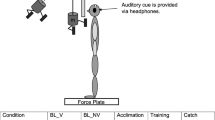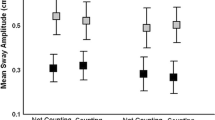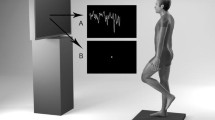Abstract
Anticipatory postural adjustments (APAs) play an important role in the performance of many activities requiring the maintenance of vertical posture. However, little is known about how variation in the available visual information affects generation of APAs. The purpose of this study was to investigate the role of different visual cues on APAs. Ten healthy young subjects were exposed to external perturbations induced at the shoulder level in standing while the level of visual information about the forthcoming perturbation was varied. The external perturbations were provided by an aluminum pendulum attached to the ceiling. The visual conditions were (1) dynamic cues (full vision and high-frequency strobe light), (2) static cues (low-frequency strobe light) and (3) no cues (eyes open in dark room). Electrical activity of the trunk and leg muscles and center of pressure displacements were recorded and quantified within the time intervals typical for APAs. The results showed that significantly larger APAs were generated in conditions with dynamic visual cues as compared to the conditions with static cues (p < 0.05). Finally, no APAs were observed in the condition where there was complete absence of any visual cues. Principal component analysis further revealed different muscle coupling patterns in the full vision and high-frequency strobe light conditions. These findings suggest the importance of using appropriate visual cues in the generation of APAs.





Similar content being viewed by others
References
Alexandrov AV, Frolov AA, Horak FB, Carlson-Kuhta P, Park S (2005) Feedback equilibrium control during human standing. Biol Cybern 93:309–322
Aruin AS, Latash ML (1995) The role of motor action in anticipatory postural adjustments studied with self-induced and externally triggered perturbations. Exp Brain Res 106:291–300
Aruin AS, Shiratori T, Latash ML (2001) The role of action in postural preparation for loading and unloading in standing subjects. Exp Brain Res 138:458–466
Bardy BG, Warren WH Jr, Kay BA (1999) The role of central and peripheral vision in postural control during walking. Percept Psychophys 61:1356–1368
Basmajian JV (1980) Electromyography—dynamic gross anatomy: a review. Am J Anat 159:245–260
Benvenuti F, Stanhope SJ, Thomas SL, Panzer VP, Hallett M (1997) Flexibility of anticipatory postural adjustments revealed by self-paced and reaction-time arm movements. Brain Res 761:59–70
Bouisset S, Zattara M (1987) Biomechanical study of the programming of anticipatory postural adjustments associated with voluntary movement. J Biomechanics 20:735–742
Bull NJ, Hunter M, Finlay DC (2003) Cue gradient and cue density interact in the detection and recognition of objects defined by motion, contrast, or texture. Perception 32:29–39
Cavanagh PR, Komi PV (1979) Electromechanical delay in human skeletal muscle under concentric and eccentric contractions. Eur J Appl Physiol Occup Physiol 42:159–163
Cian C, Esquivie D, Barraud PA, Raphel C, Ohlmann T (1997) Strobe frequency in the rod and frame effect. Percept Mot Skills 85:43–50
Clement G, Gurfinkel VS, Lestienne F, Lipshits MI, Popov KE (1985) Changes of posture during transient perturbations in microgravity. Aviat Space Environ Med 56:666–671
De Wolf S, Slijper H, Latash ML (1998) Anticipatory postural adjustments during self-paced and reaction-time movements. Exp Brain Res 121:7–19
Greenwald HS, Knill DC, Saunders JA (2005) Integrating visual cues for motor control: a matter of time. Vision Res 45:1975–1989
Hadders-Algra M (2005) Development of postural control during the first 18 months of life. Neural Plast 12:99–108 (discussion 263–172)
Howatson G, Glaister M, Brouner J, van Someren KA (2009) The reliability of electromechanical delay and torque during isometric and concentric isokinetic contractions. J Electromyogr Kinesiol 19:975–979
Klous M, Mikulic P, Latash ML (2011) Two aspects of feedforward postural control: anticipatory postural adjustments and anticipatory synergy adjustments. J Neurophysiol 105:2275–2288
Krishnan V, Aruin AS (2011) Postural control in response to a perturbation: role of vision and additional support. Exp Brain Res 212:385–397
Krishnan V, Latash ML, Aruin AS (2012) Early and late components of feed-forward postural adjustments to predictable perturbations. Clin Neurophysiol 123:1016–1026
Lacquaniti F, Maioli C (1989) The role of preparation in tuning anticipatory and reflex responses during catching. J Neurosci 9:134–148
Lord SR, Menz HB (2000) Visual contributions to postural stability in older adults. Gerontology 46:306–310
Lord SR, Clark RD, Webster IW (1991) Postural stability and associated physiological factors in a population of aged persons. J Gerontol 46:M69–M76
Magnusson M, Enbom H, Johansson R, Pyykko I (1990) Significance of pressor input from the human feet in anterior-posterior postural control. The effect of hypothermia on vibration-induced body-sway. Acta Otolaryngol 110:182–188
Massion J (1992) Movement, posture and equilibrium: interaction and coordination. Prog Neurobiol 38:35–56
Mohapatra S, Krishnan V, Aruin AS (2011) The effect of decreased visual acuity on control of posture. Clin Neurophysiol 123:173–182
Mohapatra S, Krishnan V, Aruin AS (2012) Postural control in response to an external perturbation: effect of altered proprioceptive information. Exp Brain Res 217:197–208
Owsley C, Sloane ME (1987) Contrast sensitivity, acuity, and the perception of ‘real-world’ targets. Br J Ophthalmol 71:791–796
Park S, Horak FB, Kuo AD (2004) Postural feedback responses scale with biomechanical constraints in human standing. Exp Brain Res 154:417–427
Paulus WM, Straube A, Brandt T (1984) Visual stabilization of posture. Physiological stimulus characteristics and clinical aspects. Brain 107(Pt 4):1143–1163
Santos MJ, Kanekar N, Aruin AS (2010a) The role of anticipatory postural adjustments in compensatory control of posture: 1. Electromyographic analysis. J Electromyogr Kinesiol 20:388–397
Santos MJ, Kanekar N, Aruin AS (2010b) The role of anticipatory postural adjustments in compensatory control of posture: 2. Biomechanical analysis. J Electromyogr Kinesiol 20:398–405
Schmid M, Nardone A, De Nunzio AM, Schieppati M (2007) Equilibrium during static and dynamic tasks in blind subjects: no evidence of cross-modal plasticity. Brain 130:2097–2107
Schmitz C, Martin N, Assaiante C (1999) Development of anticipatory postural adjustments in a bimanual load-lifting task in children. Exp Brain Res 126:200–204
Strang AJ, Berg WP (2007) Fatigue-induced adaptive changes of anticipatory postural adjustments. Exp Brain Res 178:49–61
Sun H, Frost BJ (1998) Computation of different optical variables of looming objects in pigeon nucleus rotundus neurons. Nat Neurosci 1:296–303
Sun HJ, Campos JL, Young M, Chan GS, Ellard CG (2004) The contributions of static visual cues, nonvisual cues, and optic flow in distance estimation. Perception 33:49–65
Toussaint HM, Michies YM, Faber MN, Commissaris DA, van Dieen JH (1998) Scaling anticipatory postural adjustments dependent on confidence of load estimation in a bi-manual whole-body lifting task. Exp Brain Res 120:85–94
Wade MG, Jones G (1997) The role of vision and spatial orientation in the maintenance of posture. Phys Ther 77:619–628
Wei K, Stevenson IH, Kording KP (2010) The uncertainty associated with visual flow fields and their influence on postural sway: Weber’s law suffices to explain the nonlinearity of vection. J Vis 10:4
Winter D (2000) Human balance and posture control during standing and walking. Gait & Posture 3:193–214
Winter DA, Prince F, Frank JS, Powell C, Zabjek KF (1996) Unified theory regarding A/P and M/L balance in quiet stance. J Neurophysiol 75:2334–2343
Yiou E, Mezaour M, Le Bozec S (2009) Anticipatory postural adjustments and focal performance during bilateral forward-reach task under different stance conditions. Mot Control 13:142–160
Zago M, Bosco G, Maffei V, Iosa M, Ivanenko YP, Lacquaniti F (2004) Internal models of target motion: expected dynamics overrides measured kinematics in timing manual interceptions. J Neurophysiol 91:1620–1634
Acknowledgments
We would like to thank Bing Chen and Nilovana Panwalkar for help during data collection. This study was supported in part by NIH grant HD-064838.
Author information
Authors and Affiliations
Corresponding author
Rights and permissions
About this article
Cite this article
Mohapatra, S., Aruin, A.S. Static and dynamic visual cues in feed-forward postural control. Exp Brain Res 224, 25–34 (2013). https://doi.org/10.1007/s00221-012-3286-2
Received:
Accepted:
Published:
Issue Date:
DOI: https://doi.org/10.1007/s00221-012-3286-2




